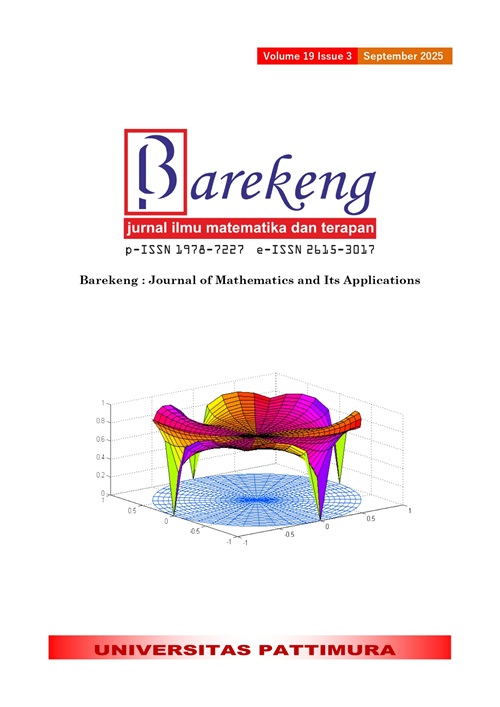MODELING TOTAL FERTILITY RATE IN INDONESIA: A COMPARISON OF FOURIER SERIES REGRESSION AND ELASTIC NET REGRESSION
Abstract
The Total Fertility Rate (TFR) describes population growth and socioeconomic development of a country. This statistic plays an important role in predicting future social and economic conditions. Indonesia has experienced a steady decline in TFR over the past few decades, which can be a serious problem if this trend continues. Therefore, the factor influencing the decline must be found. The independent variables include the percentage of women graduating high school, percentage of the poor population, poverty gap index, poverty severity index, prevalence of inadequate food consumption, proportion of people living below 50 percent of median income, unemployment rate, infant mortality rate, child mortality rate, and percentage of ever-married women aged 15–49 years using contraception methods. The aim of this study is to compare both Fourier Series Regression and Elastic Net Regression models to see which approximation can capture the TRF phenomenon that occurs in Indonesia and identify the causes of its decline. Fourier Regression is chosen because there is a repetition of patterns in several variables. Moreover, this data is experiencing multicollinearity; hence, Elastic-net Regression is the best way because this method overcomes the limitations of each Ridge and Lasso approach. These models are compared to see which is more suitable to capture the relationships between these factors and TFR. The best model obtained will provide a clearer understanding of Indonesia's underlying drivers of fertility decline. The result is that the Fourier Series Regression can model all variables better than the Elastic-net Regression, and the independent variables can explain the proportion of variance in the dependent variables by 97.91%, with all the independent variables significantly affecting the Total Fertility Rate.
Downloads
References
J. Bongaarts and G. Feeney, “ON THE QUANTUM AND TEMPO OF FERTILITY,” Population Council, 1998. doi: https://doi.org/10.31899/pgy6.1010.
OECD, SOCIETY AT A GLANCE: ASIA/PACIFIC 2019. in Society at a Glance: Asia/Pacific. OECD, 2019. doi: 10.1787/soc_aag-2019-en.
N. E. Skakkebaek et al., “MALE REPRODUCTIVE DISORDERS AND FERTILITY TRENDS: INFLUENCES OF ENVIRONMENT AND GENETIC SUSCEPTIBILITY,” Physiological Reviews, vol. 96, no. 1, pp. 55–97, Jan. 2016, doi: https://doi.org/10.1152/physrev.00017.2015.
Proyeksi penduduk Indonesia 2020-2050: Hasil Sensus Penduduk 2020. Jakarta: Badan Pusat Statistik, 2023.
S. Borzoiepour, G. Alizadeh, H. Jafary, and R. Khodayari Zarnaq, “IDENTIFY AFFECTING FACTORS ON TOTAL FERTILITY RATE: A SYSTEMATIC REVIEW,” Health Scope, vol. In Press, no. In Press, Sep. 2024, doi: https://doi.org/10.5812/healthscope-139351.
K. Borkotoky and S. Unisa, “FEMALE EDUCATION AND ITS ASSOCIATION WITH CHANGES IN SOCIO-DEMOGRAPHIC BEHAVIOUR: EVIDENCE FROM INDIA,” J. Biosoc. Sci., vol. 47, no. 5, pp. 687–706, Sep. 2015, doi: https://doi.org/10.1017/S002193201400039X.
Y. Kountouris, “HIGHER EDUCATION AND FERTILITY: EVIDENCE FROM REFORMS IN GREECE,” Economics of Education Review, vol. 79, p. 102059, Dec. 2020, doi: https://doi.org/10.1016/j.econedurev.2020.102059.
V. N. Archangelsky, S. G. Shulgin, and Yu. V. Zinkina, “REPRODUCTIVE BEHAVIOR OF RUSSIAN WOMEN AS DEPENDING ON THEIR LEVEL OF EDUCATION,” Vestnik Rossijskogo universiteta druzhby narodov. Serija Sociologija, vol. 20, no. 3, pp. 546–559, Dec. 2020, doi: https://doi.org/10.22363/2313-2272-2020-20-3-546-559.
F. Götmark and M. Andersson, “HUMAN FERTILITY IN RELATION TO EDUCATION, ECONOMY, RELIGION, CONTRACEPTION, AND FAMILY PLANNING PROGRAMS,” BMC Public Health, vol. 20, no. 1, p. 265, Dec. 2020, doi: https://doi.org/10.1186/s12889-020-8331-7.
A. Van Soest and U. R. Saha, “RELATIONSHIPS BETWEEN INFANT MORTALITY, BIRTH SPACING AND FERTILITY IN MATLAB, BANGLADESH,” PLoS ONE, vol. 13, no. 4, p. e0195940, Apr. 2018, doi: https://doi.org/10.1371/journal.pone.0195940.
A. K. L. Siah and G. H. Y. Lee, “FEMALE LABOUR FORCE PARTICIPATION, INFANT MORTALITY AND FERTILITY IN MALAYSIA,” Journal of the Asia Pacific Economy, vol. 20, no. 4, pp. 613–629, Oct. 2015, doi: https://doi.org/10.1080/13547860.2015.1045326.
D. Shapiro and M. Tenikue, “WOMEN’S EDUCATION, INFANT AND CHILD MORTALITY, AND FERTILITY DECLINE IN URBAN AND RURAL SUB-SAHARAN AFRICA,” DemRes, vol. 37, pp. 669–708, Sep. 2017, doi: https://doi.org/10.4054/DemRes.2017.37.21.
N. P. A. M. Mariati, I. N. Budiantara, and V. Ratnasari, “COMBINATION ESTIMATION OF SMOOTHING SPLINE AND FOURIER SERIES IN NONPARAMETRIC REGRESSION,” Journal of Mathematics, vol. 2020, pp. 1–10, Jul. 2020, doi: https://doi.org/10.1155/2020/4712531.
A. Prahutama, Suparti, and T. W. Utami, “MODELLING FOURIER REGRESSION FOR TIME SERIES DATA- A CASE STUDY: MODELLING INFLATION IN FOODS SECTOR IN INDONESIA,” J. Phys.: Conf. Ser., vol. 974, p. 012067, Mar. 2018, doi: https://doi.org/10.1088/1742-6596/974/1/012067.
R. Rahmania, S. Sifriyani, and A. T. R. Dani, “MODELING OPEN UNEMPLOYMENT RATE IN KALIMANTAN ISLAND USING NONPARAMETRIC REGRESSION WITH FOURIER SERIES ESTIMATOR,” BAREKENG: J. Math. & App., vol. 18, no. 1, pp. 0245–0254, Mar. 2024, doi: https://doi.org/10.30598/barekengvol18iss1pp0245-0254.
H. F. F. Mahmoud, “PARAMETRIC VERSUS SEMI AND NONPARAMETRIC REGRESSION MODELS,” IJSP, vol. 10, no. 2, p. 90, Feb. 2021, doi: https://doi.org/10.5539/ijsp.v10n2p90.
M. D. Pasarella, S. Sifriyani, and F. D. T. Amijaya, “NONPARAMETRIK REGRESSION MODEL ESTIMATION WITH THE FOURIER SERIES THE FOURIER SERIES APPROACH AND ITS APPLICATION TO THE ACCUMULATIVE COVID-19 DATA IN INDONESIA,” BAREKENG: J. Math. & App., vol. 16, no. 4, pp. 1167–1174, Dec. 2022, doi: https://doi.org/10.30598/barekengvol16iss4pp1167-1174.
Suparti, R. Santoso, A. Prahutama, A. R. Devi, and Sudargo, “MODELING LONGITUDINAL DATA BASED ON FOURIER REGRESSION,” J. Phys.: Conf. Ser., vol. 1217, no. 1, p. 012105, May 2019, doi: https://doi.org/10.1088/1742-6596/1217/1/012105.
K. Yang, J. Tu, and T. Chen, “HOMOSCEDASTICITY: AN OVERLOOKED CRITICAL ASSUMPTION FOR LINEAR REGRESSION,” Gen Psych, vol. 32, no. 5, p. e100148, Oct. 2019, doi: https://doi.org/10.1136/gpsych-2019-100148.
A. F. Schmidt and C. Finan, “LINEAR REGRESSION AND THE NORMALITY ASSUMPTION,” Journal of Clinical Epidemiology, vol. 98, pp. 146–151, Jun. 2018, doi: https://doi.org/10.1016/j.jclinepi.2017.12.006.
H. Zou, H. T., “REGULARIZATION AND VARIABLE SELECTION VIA THE ELASTIC NET,” Journal of the Royal Statistical Society. Series B (Statistical Methodology), vol. 67, no. 2, pp. 301–320, 2005.doi: https://doi.org/10.1111/j.1467-9868.2005.00503.x
F. Fitri, M. Almuhayar, T. O. Mukhti, and D. Agustina, “APPLICATION OF LOGISTIC REGRESSION WITH ELASTIC NET IN MODELING UNIVERSITY STUDENTS’ PUBLIC SPEAKING ANXIETY: A CASE STUDY,” presented at the PROCEEDINGS OF THE 38TH INTERNATIONAL CONFERENCE OF THE POLYMER PROCESSING SOCIETY (PPS-38), St. Gallen, Switzerland, 2024, p. 020010. doi: https://doi.org/10.1063/5.0223985.
Afraa A. Hamada, “ELASTIC NET PRINCIPAL COMPONENT REGRESSION WITH AN APPLICATION,” IJSME, vol. 1, no. 3, pp. 13–23, Sep. 2024, doi: https://doi.org/10.62951/ijsme.v1i3.25.
A. S. Al-Jawarneh, Mohd. T. Ismail, and A. M. Awajan, “ELASTIC NET REGRESSION AND EMPIRICAL MODE DECOMPOSITION FOR ENHANCING THE ACCURACY OF THE MODEL SELECTION,” Int J Math, Eng, Manag Sci, vol. 6, no. 2, pp. 564–583, Apr. 2021, doi: https://doi.org/10.33889/IJMEMS.2021.6.2.034.
Q. F. Xu, X. H. Ding, C. X. Jiang, K. M. Yu, and L. Shi, “AN ELASTIC-NET PENALIZED EXPECTILE REGRESSION WITH APPLICATIONS,” Journal of Applied Statistics, vol. 48, no. 12, pp. 2205–2230, Sep. 2021, doi: https://doi.org/10.1080/02664763.2020.1787355.
H. Han and K. J. Dawson, “APPLYING ELASTIC‐NET REGRESSION TO IDENTIFY THE BEST MODELS PREDICTING CHANGES IN CIVIC PURPOSE DURING THE EMERGING ADULTHOOD,” Journal of Adolescence, vol. 93, no. 1, pp. 20–27, Dec. 2021, doi: https://doi.org/10.1016/j.adolescence.2021.09.011.
D. N. Gujarati and D. C. Porter, BASIC ECONOMETRICS, 5th ed. Boston: McGraw-Hill Irwin, 2009.
W. Härdle, A. Werwatz, M. Müller, and S. Sperlich, NONPARAMETRIC AND SEMIPARAMETRIC MODELS. in Springer Series in Statistics. Berlin, Heidelberg: Springer Berlin Heidelberg, 2004. doi: https://doi.org/10.1007/978-3-642-17146-8.
T. J. Hastie, R. Tibshirani, and J. H. Friedman, THE ELEMENTS OF STATISTICAL LEARNING: DATA MINING, INFERENCE, AND PREDICTION, 2nd ed. in Springer series in statistics. New York: Springer, 2009.
J. Friedman, T. Hastie, and R. Tibshirani, “Regularization Paths for Generalized Linear Models via Coordinate Descent,” J. Stat. Soft., vol. 33, no. 1, 2010, doi: https://doi.org/10.18637/jss.v033.i01.
M. F. F. Mardianto, E. Tjahjono, and M. Rifada, “SEMIPARAMETRIC REGRESSION BASED ON THREE FORMS OF TRIGONOMETRIC FUNCTION IN FOURIER SERIES ESTIMATOR,” J. Phys.: Conf. Ser., vol. 1277, no. 1, p. 012052, Jul. 2019, doi: https://doi.org/10.1088/1742-6596/1277/1/012052.
M. Bilodeau, “FOURIER SMOOTHER AND ADDITIVE MODELS,” Can J Statistics, vol. 20, no. 3, pp. 257–269, Sep. 1992, doi: https://doi.org/10.2307/3315313.
R. L. Eubank, NONPARAMETRIC REGRESSION AND SPLINE SMOOTHING, 0 ed. CRC Press, 1999. doi: https://doi.org/10.1201/9781482273144.
Copyright (c) 2025 Fadhilah Fitri, Melin Wanike Ketrin, Mawanda Almuhayar

This work is licensed under a Creative Commons Attribution-ShareAlike 4.0 International License.
Authors who publish with this Journal agree to the following terms:
- Author retain copyright and grant the journal right of first publication with the work simultaneously licensed under a creative commons attribution license that allow others to share the work within an acknowledgement of the work’s authorship and initial publication of this journal.
- Authors are able to enter into separate, additional contractual arrangement for the non-exclusive distribution of the journal’s published version of the work (e.g. acknowledgement of its initial publication in this journal).
- Authors are permitted and encouraged to post their work online (e.g. in institutional repositories or on their websites) prior to and during the submission process, as it can lead to productive exchanges, as well as earlier and greater citation of published works.






1.gif)



